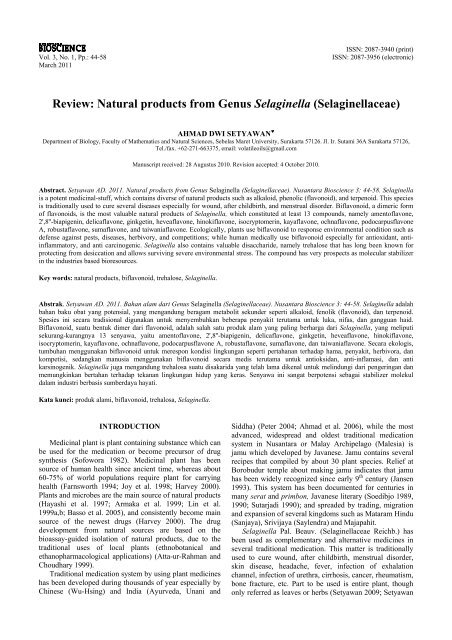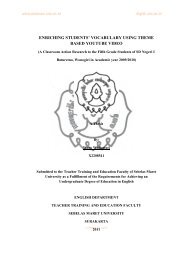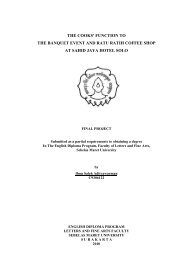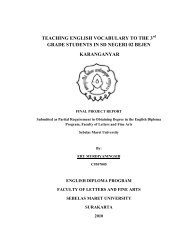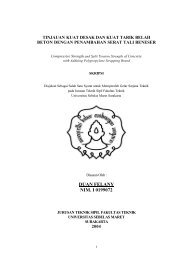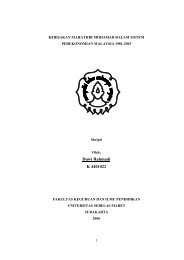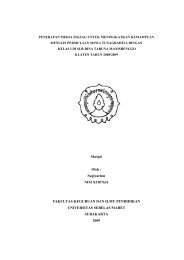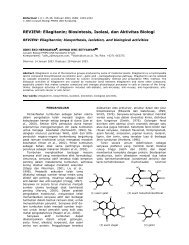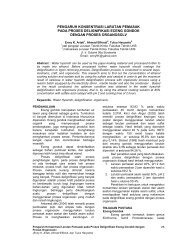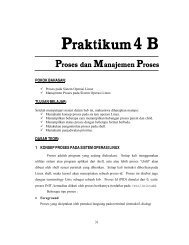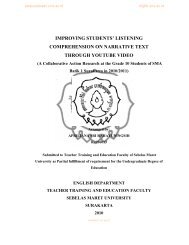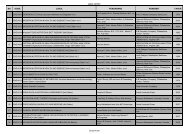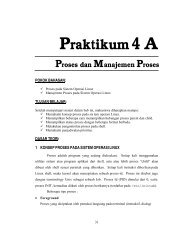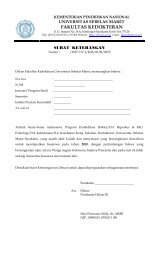ISSN 2087-3940 (PRINT) | ISSN 2087-3956 ... - Biodiversitas
ISSN 2087-3940 (PRINT) | ISSN 2087-3956 ... - Biodiversitas
ISSN 2087-3940 (PRINT) | ISSN 2087-3956 ... - Biodiversitas
Create successful ePaper yourself
Turn your PDF publications into a flip-book with our unique Google optimized e-Paper software.
Vol. 3, No. 1, Pp.: 44-58<br />
March 2011<br />
<strong>ISSN</strong>: <strong>2087</strong>-<strong>3940</strong> (print)<br />
<strong>ISSN</strong>: <strong>2087</strong>-<strong>3956</strong> (electronic)<br />
Review: Natural products from Genus Selaginella (Selaginellaceae)<br />
AHMAD DWI SETYAWAN ♥<br />
Department of Biology, Faculty of Mathematics and Natural Sciences, Sebelas Maret University, Surakarta 57126. Jl. Ir. Sutami 36A Surakarta 57126,<br />
Tel./fax. +62-271-663375, email: volatileoils@gmail.com<br />
Manuscript received: 28 Augustus 2010. Revision accepted: 4 October 2010.<br />
Abstract. Setyawan AD. 2011. Natural products from Genus Selaginella (Selaginellaceae). Nusantara Bioscience 3: 44-58. Selaginella<br />
is a potent medicinal-stuff, which contains diverse of natural products such as alkaloid, phenolic (flavonoid), and terpenoid. This species<br />
is traditionally used to cure several diseases especially for wound, after childbirth, and menstrual disorder. Biflavonoid, a dimeric form<br />
of flavonoids, is the most valuable natural products of Selaginella, which constituted at least 13 compounds, namely amentoflavone,<br />
2',8''-biapigenin, delicaflavone, ginkgetin, heveaflavone, hinokiflavone, isocryptomerin, kayaflavone, ochnaflavone, podocarpusflavone<br />
A, robustaflavone, sumaflavone, and taiwaniaflavone. Ecologically, plants use biflavonoid to response environmental condition such as<br />
defense against pests, diseases, herbivory, and competitions; while human medically use biflavonoid especially for antioxidant, antiinflammatory,<br />
and anti carcinogenic. Selaginella also contains valuable disaccharide, namely trehalose that has long been known for<br />
protecting from desiccation and allows surviving severe environmental stress. The compound has very prospects as molecular stabilizer<br />
in the industries based bioresources.<br />
Key words: natural products, biflavonoid, trehalose, Selaginella.<br />
Abstrak. Setyawan AD. 2011. Bahan alam dari Genus Selaginella (Selaginellaceae). Nusantara Bioscience 3: 44-58. Selaginella adalah<br />
bahan baku obat yang potensial, yang mengandung beragam metabolit sekunder seperti alkaloid, fenolik (flavonoid), dan terpenoid.<br />
Spesies ini secara tradisional digunakan untuk menyembuhkan beberapa penyakit terutama untuk luka, nifas, dan gangguan haid.<br />
Biflavonoid, suatu bentuk dimer dari flavonoid, adalah salah satu produk alam yang paling berharga dari Selaginella, yang meliputi<br />
sekurang-kurangnya 13 senyawa, yaitu amentoflavone, 2',8''-biapigenin, delicaflavone, ginkgetin, heveaflavone, hinokiflavone,<br />
isocryptomerin, kayaflavone, ochnaflavone, podocarpusflavone A, robustaflavone, sumaflavone, dan taiwaniaflavone. Secara ekologis,<br />
tumbuhan menggunakan biflavonoid untuk merespon kondisi lingkungan seperti pertahanan terhadap hama, penyakit, herbivora, dan<br />
kompetisi, sedangkan manusia menggunakan biflavonoid secara medis terutama untuk antioksidan, anti-inflamasi, dan anti<br />
karsinogenik. Selaginella juga mengandung trehalosa suatu disakarida yang telah lama dikenal untuk melindungi dari pengeringan dan<br />
memungkinkan bertahan terhadap tekanan lingkungan hidup yang keras. Senyawa ini sangat berpotensi sebagai stabilizer molekul<br />
dalam industri berbasis sumberdaya hayati.<br />
Kata kunci: produk alami, biflavonoid, trehalosa, Selaginella.<br />
INTRODUCTION<br />
Medicinal plant is plant containing substance which can<br />
be used for the medication or become precursor of drug<br />
synthesis (Sofowora 1982). Medicinal plant has been<br />
source of human health since ancient time, whereas about<br />
60-75% of world populations require plant for carrying<br />
health (Farnsworth 1994; Joy et al. 1998; Harvey 2000).<br />
Plants and microbes are the main source of natural products<br />
(Hayashi et al. 1997; Armaka et al. 1999; Lin et al.<br />
1999a,b; Basso et al. 2005), and consistently become main<br />
source of the newest drugs (Harvey 2000). The drug<br />
development from natural sources are based on the<br />
bioassay-guided isolation of natural products, due to the<br />
traditional uses of local plants (ethnobotanical and<br />
ethanopharmacological applications) (Atta-ur-Rahman and<br />
Choudhary 1999).<br />
Traditional medication system by using plant medicines<br />
has been developed during thousands of year especially by<br />
Chinese (Wu-Hsing) and India (Ayurveda, Unani and<br />
Siddha) (Peter 2004; Ahmad et al. 2006), while the most<br />
advanced, widespread and oldest traditional medication<br />
system in Nusantara or Malay Archipelago (Malesia) is<br />
jamu which developed by Javanese. Jamu contains several<br />
recipes that compiled by about 30 plant species. Relief at<br />
Borobudur temple about making jamu indicates that jamu<br />
has been widely recognized since early 9 th century (Jansen<br />
1993). This system has been documented for centuries in<br />
many serat and primbon, Javanese literary (Soedibjo 1989,<br />
1990; Sutarjadi 1990); and spreaded by trading, migration<br />
and expansion of several kingdoms such as Mataram Hindu<br />
(Sanjaya), Srivijaya (Saylendra) and Majapahit.<br />
Selaginella Pal. Beauv. (Selaginellaceae Reichb.) has<br />
been used as complementary and alternative medicines in<br />
several traditional medication. This matter is traditionally<br />
used to cure wound, after childbirth, menstrual disorder,<br />
skin disease, headache, fever, infection of exhalation<br />
channel, infection of urethra, cirrhosis, cancer, rheumatism,<br />
bone fracture, etc. Part to be used is entire plant, though<br />
only referred as leaves or herbs (Setyawan 2009; Setyawan


